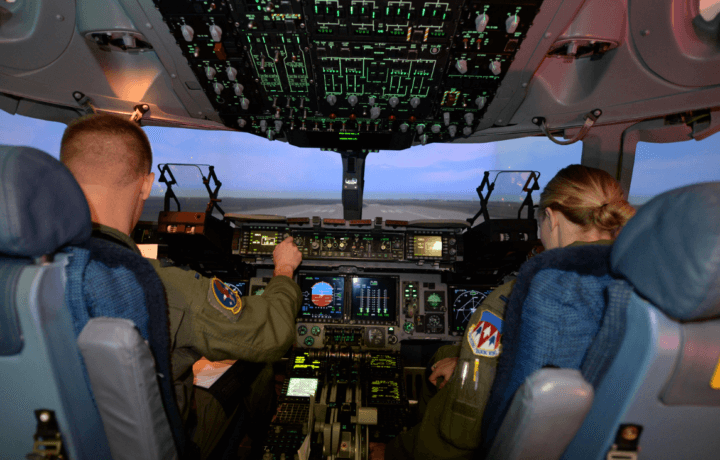One of the ways the Air Force trains pilots for combat is through simulators. And the Air Force has a lot of simulators, thousands of them. But the challenge is accessing them all. The Air Force is looking into ways to make it so that the computer systems and software can exchange and use other simulator’s information to give agility and flexibility to each training system.
Common Simulation Training Environment (CSTE)
The Air Force Life Cycle Management Center’s Architecture and Integration Directorate (AFLCMC/AI ) is looking into this and working on addressing the issue of the lack of communication between systems. According to the National Defense Magazine, the Common Simulation Training Environment (CSTE) may be the solution. The goal is to create an environment where training systems can better link together giving the Air Force the ability to better train large numbers of airmen at the level required. Currently “simulators are often proprietary products, and there is no way for these simulators to communicate,” said Kevin McFarland, acquisition lead for modeling and simulation at AFLCMC/AI.
The way it has always been done is no longer a good path forward for the Air Force. So, they are working to change that and hope that CSTE will be able to solve the challenges they are currently facing. The CSTE has been described to update the same way a smartphone can refresh its software on a continual basis. The system will allow for operating system updates and new applications.
And while this solution seems like the best path forward, it isn’t as easy to implement in practical ways. It will require industry’s help to figure out how to avoid potential challenges with reproducing similar features seen in current smartphones. It is a huge pivot for the defense industry. The Air Force is plans to release requests for proposals by the end of the fiscal year. A request for information (RFI) was published in June. In the RFI it mentions that “potential business sources in transforming the data architecture and reducing infrastructure acquisition risks for a complex battlespace synthetic environment.”
Air Force and Space Force Both Need to be Connected
And the focus on created a connected simulation system within the Air Force and Space Force are not only focused on readiness for pilots but “At the highest levels of Air Force it’s been very clear that simulators are key to … readiness,” said Col. John Kurian, senior materiel leader of the simulators division at the Air Force Life Cycle Management Center.
At an Air Force Association event in 2020, Col Kurian was talking about the issues the Space Force is having with simulators being offline versions of the command and control consoles. The change needs to be focused around promoting networking of technologies and getting away from stovepipes and segregated missions.
“[The] challenge for us has been to have the ability to simulate the entire Air Force going to war, really getting at the gaming industry, the multiplayer options that we see out there and pushing us as an organization to partner with small businesses, nontraditional partners, utilizing pitch days, and really pushing the boundaries on innovation, specifically in terms of cloud [computing] and common architectures and even artificial intelligence.”
The Air Force and Space Force are working to change and with the proposals and work being done by AFLCMC, we can hope to see these changes implemented in the future and change the way the military trains and prepares for war.




